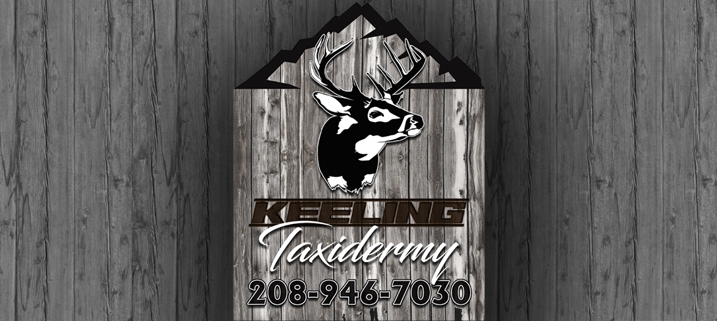Field Dressing
A note of caution: Because of the various diseases that wild game can transmit to humans, always use extreme caution when handling the carcass. Use rubber or latex gloves and thoroughly wash your hands with soap and water after handling.
With the deer on its back, make a shallow cut through the skin just below the breastbone. Make sure that you start your cut well away from the brisket, allowing plenty of uncut skin for your shoulder mount. Insert two fingers of the free hand,cradling the blade, to hold the skin up and away from the entrails. |
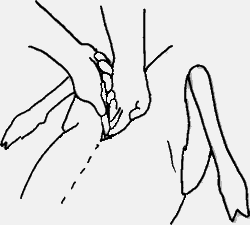 |
|---|
Cut straight down the belly and around the genitals, separating but not severing them from the abdominal wall. Slit the belly skin all the way to the pelvic bone. Note: Start the incision below the caping line. Cut deeply around the rectum, being careful not to cut off or puncture the intestine. Pull to make sure the rectum is separated from tissue connecting it to the pelvic canal. Pull the rectum out and tie string tightly around it to prevent droppings from touching the meat. Lift the animal's back quarter a bit, reach into the front of the pelvic canal, and pull the intestine and connected rectum into the stomach area. |
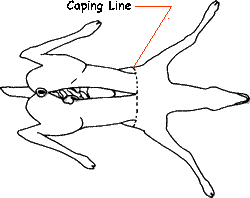 |
|---|
If you want to make a full shoulder mount, do not cut open the chest cavity. Cut the diaphragm away from the ribs all the way to the backbone area. Reach into the forward chest cavity, find the esophagus and wind pipe, cut them off as far up as possible and pull them down through the chest. Roll the deer onto its side, grab the esophagus with one hand and the rectum/intestine with the other. Pull hard. The deer's internal organs will come out in one big package with a minimum of mess. |
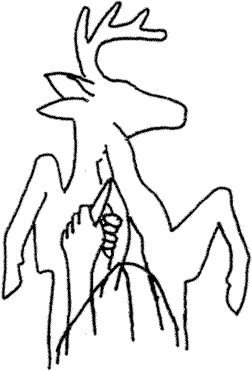 |
|---|
Caping, the process of skinning out a trophy animal, is best left to the taxidermist. Their experience skinning, especially the delicate nose, mouth, eyes, and ears is invaluable toward producing a quality mount. Damage to a hide is costly to repair. Some types of damage simply cannot be "fixed" by the taxidermist. Many trophies are ruined in the first few hours after death. As soon as the animal dies, bacteria begins to attack the carcass. Warm, humid weather accelerates bacteria growth. In remote areas, or areas not near your taxidermist, a competent person may be required to cape out the hide in order to preserve it. Every taxidermist has a preferred method of caping a hide. Contact your taxidermist prior to your hunt in order to get instructions on their caping requirements. However, the following techniques are generally acceptable. |
|---|
Skinning Life-Size Big GameThere are two major methods of skinning for a large life-size mount such as deer, elk, or bear. These methods are the flat incision and the dorsal method. |
|---|
The Flat IncisionThe flat incision is used for rug mounts and for a variety of poses. Make these slits (cutting the feet free from the carcass) and pull the skin off the carcass. The head is detached as with the shoulder mount. Note:If you can't take your hide immediately to a taxidermist, freeze it to your taxidermist's specifications. |
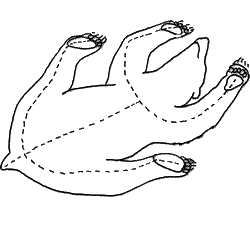 |
|---|
The Dorsal MethodThe dorsal method of skinning involves a long slit down the back (from the tail base up into the neck). The carcass is skinned as it is pulled through this incision. The feet / hooves and the head are cut from the carcass as with a shoulder mount explained later. Only use this method with approval and detailed instructions from your taxidermist. Use this method only when the skin can be frozen quickly after skinning. |
|---|
Caping for a Shoulder MountWith a sharp knife, slit the hide circling the body behind the shoulder at approximately the midway point of the rib cage behind the front legs. Slit the skin around the legs just above the knees. An additional slit will be needed from the back of the leg and joining the body cut behind the legs. |
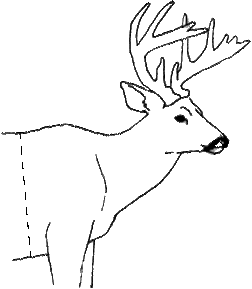 |
|---|
Peel the skin forward up to the ears and jaw exposing the head/neck junction. Cut into the neck approximately three inches down from this junction. Circle the neck, cutting down to the spinal column. After this cut is complete, grasp the antler bases, and twist the head off the neck. This should allow the hide to be rolled up and put in a freezer until transported to the taxidermist. |
|---|
These cuts should allow ample hide for the taxidermist to work with in mounting. Remember, the taxidermist can cut off excess hide, but he can't add what he doesn't have. |
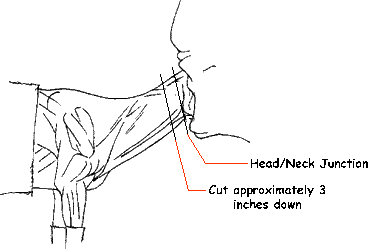 |
|---|
When field dressing a trophy to be mounted, don't cut into the brisket (chest) or neck area. If blood gets on the hide to be mounted, wash it off with snow or water as soon as possible. Avoid dragging the deer out of the woods with a rope. Place it on a sled, a rickshaw, or a four-wheeler. The rope, rocks, or a broken branch from a deadfall can easily damage the fur or puncture the hide. If you do need to drag it our with a rope, attach the rope to the base of the antlers and drag your trophy carefully. |
|---|
Small MammalsAnimals, coyote sized or smaller, should not be skinned unless by a professional. Don't gut the animal. Small mammals, especially carnivores, will spoil quickly because of their thin hide and bacteria. If you can't take the small game animal immediately to a taxidermist, as soon as the carcass cools completely, put it in a plastic bag and freeze it. With the epidemic of rabies evident in many areas of the country, take every safety measure necessary when handling your game. |
|---|
TipsAlways have appropriate tags with your trophies when you take them to your taxidermist.
This document is copyrighted by McKenzie Sports Products, Inc. and is intended to help hunters avoid common mistakes in the field. Printing of more than one copy at a time without written permission is prohibited. |
|---|
| Home | About | We Love To Do | Photo Gallery | Prices | Contact |
|---|
